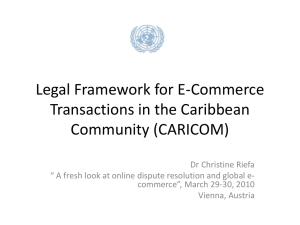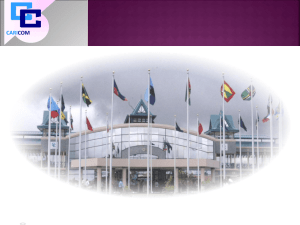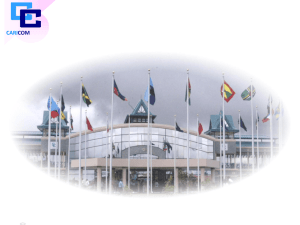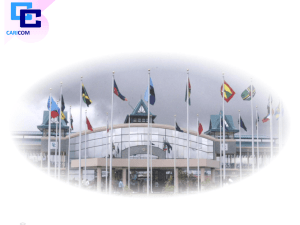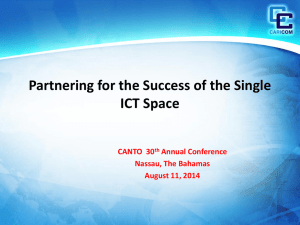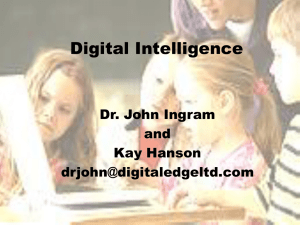ICT Workshop - Environment Issues
advertisement
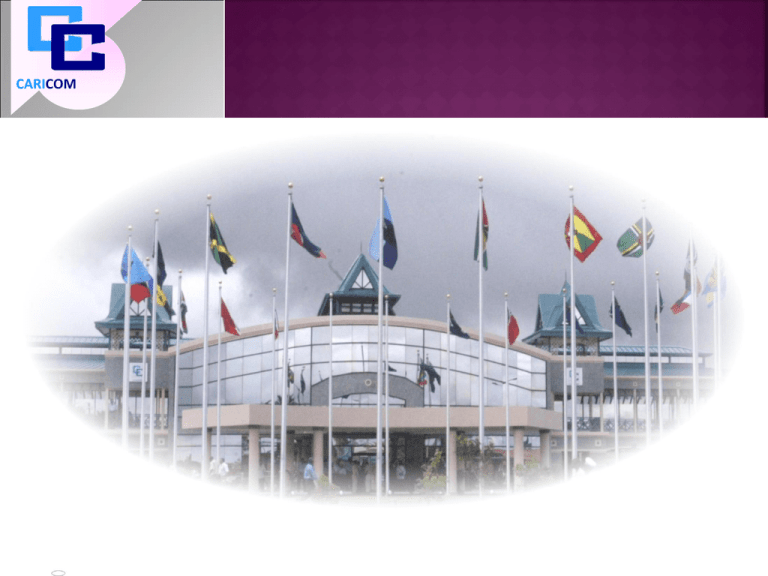
CARICOM CARICOM CARICOM • Definition • ICT and the environment • Sub-Themes • Indicators and Rationale CARICOM The environment is defined as “ the totality of all the external conditions affecting the life, development and survival of an organism. " Source: Glossary of Environment Statistics, Studies in Methods, Series F, No. 67, United Nations, New York, 1997. CARICOM A broad concept of environment is assumed to include: climate change, energy, water, sustainable development, pollution, waste, land use and degradation, and conservation of species and ecosystems. These elements are not mutually exclusive. CARICOM Environmental impacts: Agents to improve environmental outcomes (efficiency, dematerialisation, role in monitoring, administration and dissemination). Contributors to environmental damage (energy usage in, and emissions from, manufacturing, transport and operation; pollution from disposal). CARICOM The sub-themes identified under this area are: Climate Change Energy Consumption Waste/e-waste Land use Water resources Conservation of ecosystems CARICOM Climate change refers to a change of climate which is attributed directly or indirectly to human activity that alters the composition of the global atmosphere and which is in addition to natural climate variability observed over comparable time periods. (UN Framework Convention on Climate Change (UNFCCC) ) CARICOM Proposed Caribbean Specific Indicators Rationale Total emissions of carbon dioxide from the ICT sector Key indicator of contribution to climate change, Total emissions of carbon dioxide from the ICT sector as a per cent of the total of GHG emissions Number and type of telecommunications equipment used in weather forecasting and monitoring Measures the role of ICT in climate monitoring and weather forecasting Incidence of mobile telephone technology being used to provide climate related information and alerts Used to inform and raise awareness (e.g., media campaigns) at all levels of society – including the poor – about the effects of climate change. Can be used for coordination of emergency efforts, and dissemination of locally specific and relevant information (e.g., early-warning systems, meteorological information for preparedness disseminated through telecentres or mobile phones). CARICOM Energy consumption refers to all the energy used for heat, power, and electricity generation, regardless of where the energy was produced. Energy products can be used for various purposes (e.g., as an input in production of secondary energy products or for final consumption) and by different user groups (e.g., various industries and households). CARICOM Proposed Caribbean Specific Indicators Total electricity consumption by ICT sector Rationale Measures the effect of ICT on energy demands Measures ICT potential for Energy efficiency Total energy consumption by ICT CARICOM IE-waste is a generic term encompassing various forms of electrical and electronic equipment (EEE) that are old, end-of-life electronic appliances and have ceased to be of any value to their owners. A practical definition of e-waste is ‘any electrically powered appliance that fails to satisfy the current owner for its originally intended purpose’. E-waste is also synonymously called WEEE (pronounced W-triple E), short for Waste Electrical and Electronic Equipment as defined under Annex IA of the Directive 2002/96/EC of the European Parliament and of the Council. CARICOM Proposed Caribbean Specific Indicators Total amount of e-waste collected by type and quantity Total e-waste collected as a percentage of total municipal waste collected Total amount of e-waste being recycled by type and quantity Total e-waste recycled as a percentage of total municipal waste collected Rationale The objective of this indicator is to quantify the amount of electronic waste discarded and e-waste recycling efforts. Toxic and hazardous elements are present in e-waste and therefore proper handling and treatment of such harmful elements to prevent environmental or health impact is necessary. The appropriate handling of e-waste can both prevent serious environmental damage and also recover valuable materials, especially for metals E-waste disposal has direct and indirect effects on human health conditions. . CARICOM Land use refers to the functional division of land for different human purposes or economic activities. (Please refer to the OECD’s Glossary of Statistical Terms website at http://stats.oecd.org/glossary/) CARICOM Proposed Specific Indicators Justification ICT has the potential to facilitate land management processes and activities. Number of ICT equipment and applications used for Land Use Management by Type ICT applications can be used in urban planning (i.e. GIS), and in monitoring and provision of relevant environmental information to support decision-making processes contributing to the adaptation of human habitats and infrastructure. Good land information creates better land use policy. CARICOM The International Glossary of Hydrology defines water resources as water available, or capable of being made available, for use in sufficient quantity and quality at a location and over a period of time appropriate for an identifiable demand. CARICOM Proposed Caribbean Specific Indicators Rationale ICT Equipment and applications being used to monitor the water supply Supports MDG Goal 7 Target 7.C: Halve, by 2015, the proportion of people without sustainable access to safe drinking water and basic sanitation ICT tools used in Water Distribution Water smart meters and ICT tools to support leak detection, automated meter reading through communication networks CARICOM An ecosystem is defined as a community of plants, animals and smaller organisms that live, feed, reproduce and interact in the same area or environment This will include systems for managing specific natural areas or ecosystems such as coasts, i.e. coastal zone management systems, mountains, etc; CARICOM Proposed Caribbean Specific Indicators Rationale ICT tools and applications used to monitor the ecosystem Protected Areas monitored using ICT Biodiversity monitored using ICT by species Used for observation, monitoring and networking changes in the ecosystems Used for environment management and protection CARICOM THANKS!
